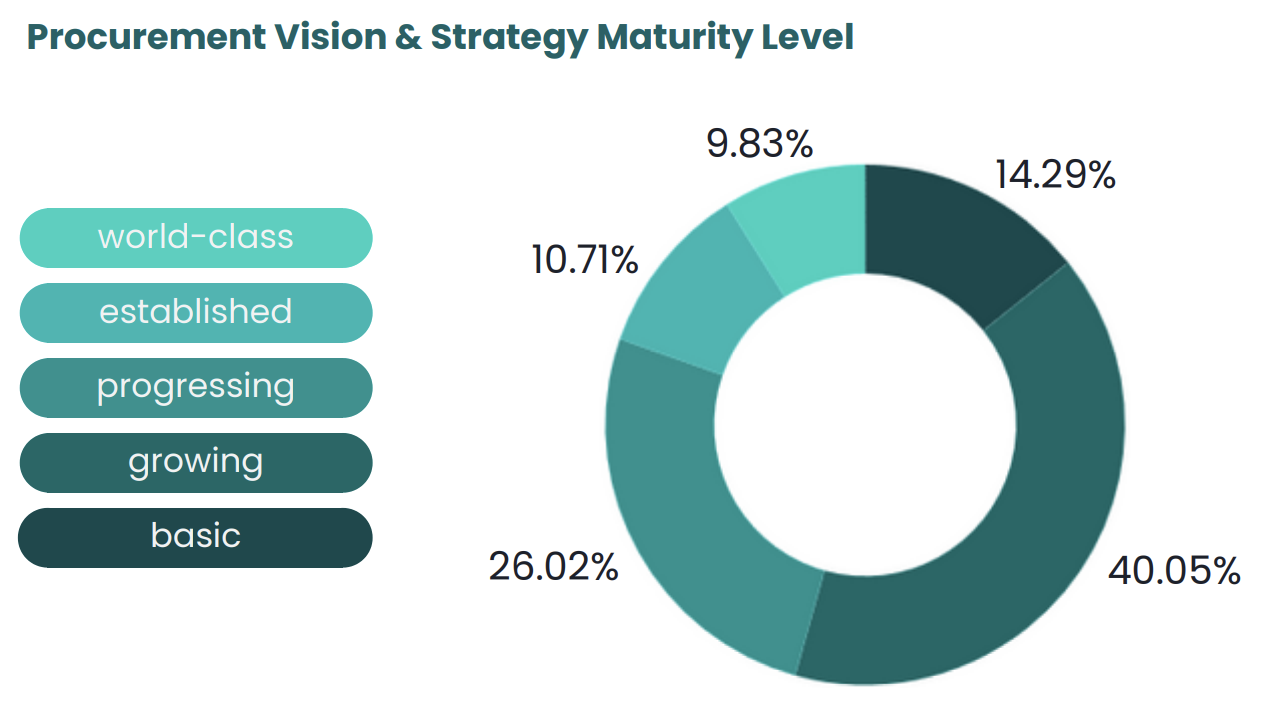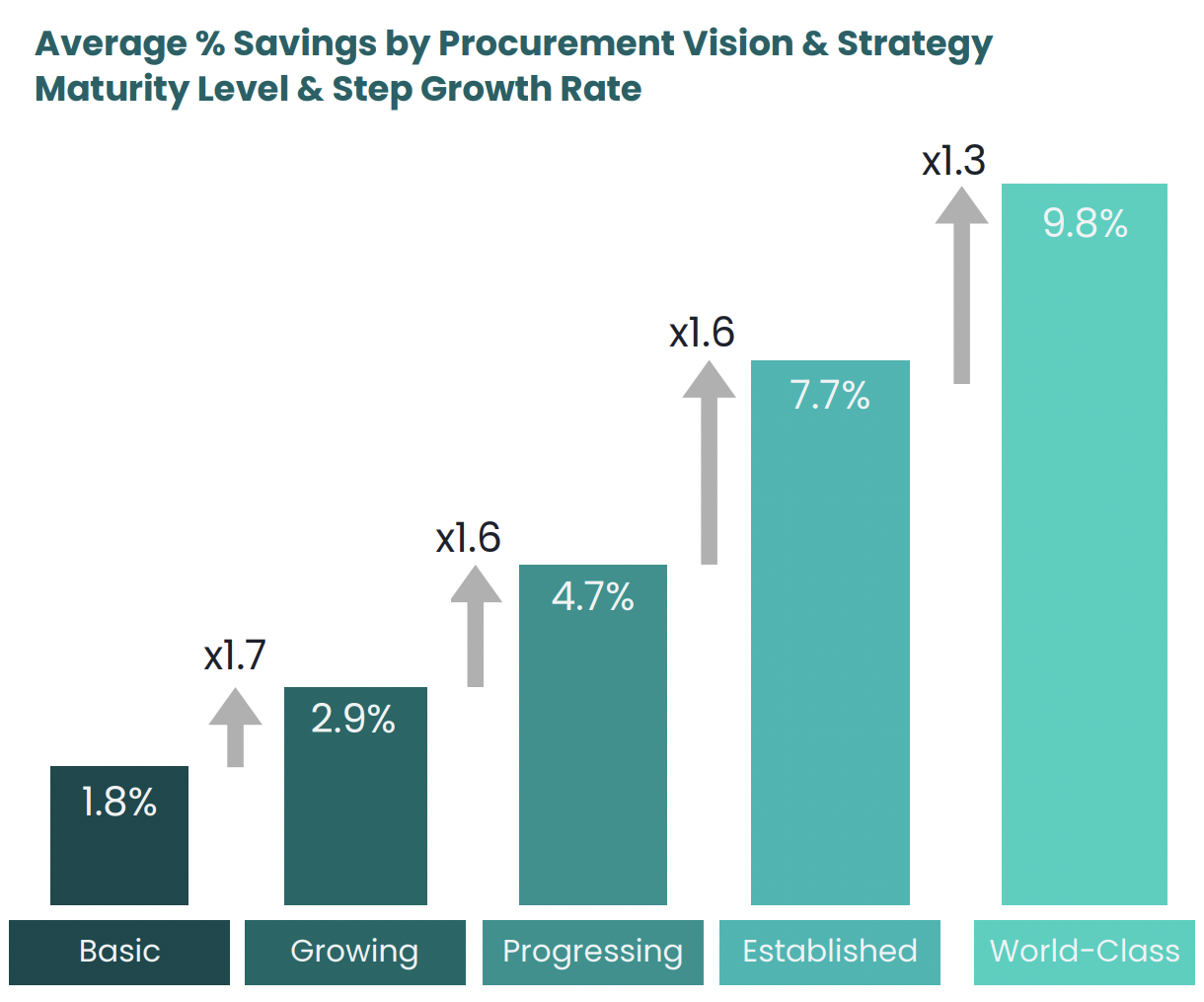In today’s fast-moving, increasingly complex and cost-conscious business landscape having a clear procurement vision and strategy aligned to the wider business objectives has never been more critical. By developing their procurement function, an organisation could save up to £26.6 million in spend by moving from ‘Progressing’ to ‘Established’. Recent findings from our Annual Transformative Procurement Survey, reveal that despite growing awareness of procurement’s strategic value, most organisations remain in the early stages of developing their procurement vision and strategy. As a result, procurement functions are not able to deliver the level of impact and value that can be achieved.
Over half (54%) of surveyed organisations remain at the “Basic” or “Growing” stage, with fewer than 5% having a fully developed and well-communicated procurement strategy.
While only 6.6% of organisations participating in the survey lacked any procurement strategy at all, over half (54%) remain at the “Basic” or “Growing” stage, with fewer than 5% having a fully developed and well-communicated procurement strategy.
This gap between aspiration and effective execution means many organisations struggle to translate goals into robust long-term plans. Without a clear and communicated procurement strategy, organisations risk falling behind more agile competitors and underutilising their procurement potential.
Procurement Vision and Strategy Maturity Trends: A Mixed Picture
The current state of Procurement Vision & Strategy across organisations reveals a mixed picture of progress and opportunity. On average, maturity levels remain at the lower end of the ‘Progressing’ level, a slight decrease from last year’s position. Notably, 54% of organisations are classified as ‘Basic’ or ‘Growing’, which is a significant increase of 10%, reflecting that a greater number of procurement teams are in the early stages of gaining visibility and control of their vision and strategy. While this demonstrates that progress is being made, it also suggests that many organisations are only just laying the foundational groundwork necessary for long-term success.
At the other end of the spectrum, last year’s figures showed encouraging signs with 12% of organisations being at a ‘World-Class’ maturity level. However, this year’s figure has dropped to 9%, suggesting that some organisations may be losing strategic ground – likely due to a greater need to focus on operational procurement challenges like supply chain uncertainty and the need for enhanced financial performance.

The Cost of Falling Behind in Procurement Maturity
When it comes to savings and bottom-line performance, the differences between maturity levels are clear. Organisations with a ‘World-Class’ procurement vision and strategy have been delivering 5.6x more savings (8.1%) compared to those operating at a ‘Basic’ level.
However, the largest opportunity for improvement lies in the shift from ‘Progressing’ to ‘Established’ maturity. This single step could unlock a 7.7% saving, which translates into a 1.6x increase between the two levels. To put that into perspective, for an organisation with £1.2 billion in external spend, moving up a maturity level could result in an extra £26.6 million in value.

Strategic Alignment: The Foundation of an Effective Procurement Vision & Strategy
While the majority of organisations report having a procurement vision and strategy in some form, only 4.9% have a clear, well-communicated approach that is used across the business’s operations. This highlights a clear opportunity for organisations to adopt a more strategic, long-term focus on value delivery objectives that drive both bottom-line and top-line growth. Supporting this, just over a quarter (28.6%) of businesses either lack a strategy entirely or have a very basic one focused mainly on short-term cost reduction, which limits their ability to deliver value across the organisation.
This picture is made even worse when we consider wider business alignment. 42% of organisations stated that their procurement vision and strategy has no or limited alignment with their business objectives. The resulting missed opportunity is significant when we know that organisations with full alignment of procurement vision and strategy, with short and long-term business objectives, all achieved savings approaching 10%.
Overcoming Organisational Barriers to Procurement Vision & Strategy
A major obstacle is that a significant majority (73.2%) of procurement teams exhibit only limited recognition, understanding, and buy-in regarding their strategies focused on growth and value improvement. Many organisations still focus on very short-term objectives and lack a clear roadmap to achieve long-term growth and value enhancement.
This challenge is exacerbated because many organisations do not have strong frameworks in place to measure performance or lack a clear idea of what ‘success’ looks like for procurement teams. At the same time, there are significant capability gaps, not just in the procurement and supply chain function, but across the wider organisation. However, with a stronger understanding of the broader operating model, addressing these issues could be relatively straightforward for many organisations.
The opportunity lies in taking a more integrated, long-term approach to strategy, performance and capability development.
The Road Ahead: Procurement Vision & Strategy as a Competitive Advantage
Our research reveals a stark disconnect between aspiration and execution in procurement strategy. To build a more effective procurement vision and strategy, organisations should:
- Begin by establishing a clear and long-term plan that acts as a guiding ‘North Star’ for decision-making, supporting key business objectives. This vision and strategy must be clearly communicated across the organisation.
- Develop a detailed roadmap that breaks the strategy into practical, sequential steps to support implementation and drive transformational change.
- Consider the interdependencies across the elements of the operating model, ensuring alignment and coherence throughout the organisation.
The decline in procurement strategy maturity is not just a performance issue; it’s a strategic risk. Organisations that fail to build and embed a clear procurement vision and strategy will find themselves increasingly outpaced by more agile, aligned, and forward-looking competitors.
If you would like to benchmark your organisation against over 400 organisations who participated in our research or understand more about how to improve the maturity of your procurement and supply chain function, please contact Allison Ford-Langstaff , Managing Partner or Paul Ireland, Manager, Research and Insights at 4C.
Published
October 22nd 2025